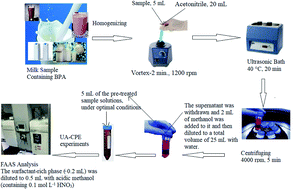An indirect method for the analysis of bisphenol A, as a Mn(iii)–chelate complex, in milk samples by ultrasound assisted-cloud point extraction/flame atomic absorption spectrometry
Abstract
A method for indirect determination of bisphenol A (BPA), as a Mn(III)–chelate complex, in milk samples by flame atomic absorption spectrometry (FAAS) was developed. The method was based on cloud point extraction with ultrasound assistance (UA-CPE). In the pre-concentration step by UA-CPE, the ternary complex selectively formed between BPA and Mn(III)–oxalate at pH 5.0 was extracted into the mixed micellar phase of ionic and nonionic surfactants, cetyltrimethylammonium bromide (CTABr) and polyethylene glycol tert-octylphenyl ether (Triton X-114) as a sensitivity enhancer and extractant. After phase separation by centrifugation, the separated extract was diluted with acidic methanol and analyzed by FAAS. The reproducibility of the signal in the detection step especially at low concentrations was greatly improved by the use of polyvinyl alcohol (PVA) as a stabilizer. Using indirect Mn-responses by FAAS, the main variables affecting the extraction efficiency were evaluated and optimized. Under optimized conditions, the calibration graph was highly linear in the range of 0.8–130 μg L−1 with limits of detection and quantification of 0.23 and 0.76 μg L−1, intra- and inter-day precisions in the range of 2.8–5.2% and 3.8–7.2%, and recovery in the range of 94.2–98.5% (10, 25, 100 μg L−1, n: 5 and 3 × 5). From pre-concentration of a 35 mL sample by UA-CPE, the pre-concentration factor was found to be 70 with a 41-fold sensitivity improvement. The matrix effect was greatly reduced by deproteinization with trichloroacetic acid (TCA) and 20-fold dilution of milk samples before analysis. The method accuracy was checked by analysis of trace BPA in milk samples via a calibration curve in solvent and a matrix-matched calibration curve prepared from sample extracts. The results were in the range of 2.1–7.3 μg L−1 and 2.0–7.0 μg L−1 without any matrix effect. According to the Student's t-test, there is not a statistically significant difference between the results found by using the two calibration curves. Finally, it can be concluded that the method is suitable for detecting BPA in milk based products at concentrations far below the specific migration limit (SML) of 600 μg L−1.



 Please wait while we load your content...
Please wait while we load your content...